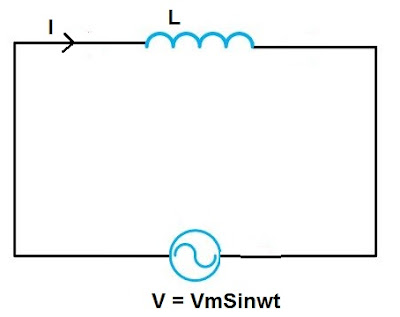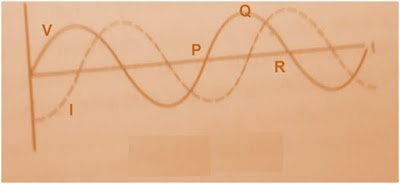For understanding the reason, why current through and Inductor lags behind Voltage across the Inductor, we will first go mathematically then we will understand the concept analytically. Let us consider a purely inductive circuit as shown in figure below.
As shown in the figure above, an inductor of value L Henray is connected with an AC supply source V = VmSinωt.
According to Kirchhoff’s loop law, the voltage induced across the Inductor will be equal to the supply voltage and therefore we can write as below.
VmSinωt = Voltage induced across Inductor
But induced emf in an Inductor is Ldi/dt and therefore,
VmSinωt = Ldi/dt
⇒ Ldi = VmSinωtdt
Integrating both sides, we get
i = (Vm/wL)Cosωt + C
where C is some constant.
Now, as the average value of Cosωt over one time period is zero and the supply voltage in our discussion in sinusoidal, therefore we expect the current to be also sinusoidal. Therefore, the value of constant C must be zero here in our case.
⇒ i = (Vm/ωL)Cosωt
⇒ i = (Vm/ωL)Sin (ωt – π/2)
Thus from the above expression, we observe that the phase difference between the applied voltage V = VmSinωt and current through Inductor i = (Vm/ωL)Sin (ωt – π/2) is π/2. This means that the current through an inductor is lagging behind the applied voltage V by an angle of 90°.
This was mathematical calculation to show that current through an inductor is lagging the supply voltage by an angle of 90°. But now we will discuss the same aspect but in analytical way. For analytical discussion we will assume steady state condition.
As we know that when a current flows through a solenoid, a magnetic field is created by the solenoid which remain confined inside the solenoid only. Now suppose, the current through the solenoid is changing with time, that simply means that magnetic flux will also change resulting into change in magnetic flux. As the coil of solenoid is linking with this changing magnetic flux, an emf will be induced in the solenoid in such a direction to oppose the cause in occurrence with Lenz’s Law. Here the cause is current flowing through the solenoid, therefore the emf will be induced in such a direction to oppose the flow of current. Here solenoid is Inductor.
Let us consider steady state where the supply voltage V is going positive from zero (point P in the figure below). In this case, as the back emf of inductor will also be zero and therefore the current flowing through the circuit will be maximum. Now as the supply voltage increases in positive direction, back emf of inductor will also rise but in opposite direction due to which the current flow through the circuit will start decreasing and will become zero when the back emf of inductor becomes maximum equal to the supply voltage as at that time supply voltage become maximum positive (point Q in figure below). After that, the supply voltage will start decreasing from it maximum value, but as the back emf of inductor is maximum but opposite in direction, the current through the circuit will change its direction. As the current in the circuit is flowing in opposite direction, the back emf of inductor will start building up in opposite to the direction of flow of current and hence net back emf of inductor will decrease and will reach to zero when supply voltage reaches zero. At this point (R) maximum current through the circuit will flow.
Thus we see that, it is the generation of back emf in the inductor which forces the current flowing through it to lag by applied voltage.


Bro i was asking why the current just when we apply the voltage i.e., at v=0 is maximum in negative, obviously if practically notice their is no current initially so how just applying the voltage that too at zero is diifferent than no source, logically still the inductor need to have zero current cause just like before applying source at time t=0 will have zero input, so what makes the circuit reach to negative max, even though we may consider the changing nature of voltage still why negative and that too at its max, why not increasing slowly to negative max, as for inductor sudden change is not possible.